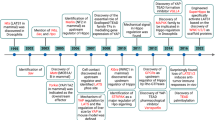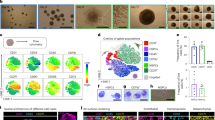Abstract
Mouse embryos lacking the Runx1 transcription factor exhibit an angiogenic defect accompanied by the absence of hematopoietic stem cells (HSCs). To ask whether Runx1 plays a direct role in angiogenesis, we established a novel endothelial progenitor cell line, designated AEL-ΔR1, from the aorta-gonad-mesonephros (AGM) region of Runx1-null mouse. We introduced Runx1 cDNA into AEL-ΔR1 cells under the doxycycline-inducible promoter. The ability of AEL-ΔR1 cells to form vascular networks on matrigel was highly enhanced by the restored expression of Runx1. By molecular comparison of mRNAs in AEL-ΔR1 cells before and after the induction of Runx1, we found that mRNA expression of insulin-like growth factor-binding protein 3 (IGFBP-3) is downregulated by Runx1. Gel retardation and reporter assays revealed that Runx1 binds to the promoter region of mouse IGFBP-3 gene and represses its transcription. When IGFBP-3 was exogenously added in the matrigel assay, the angiogenesis-enhancing activity of Runx1 was suppressed in a dose-dependent manner. These results demonstrate that Runx1 is directly involved in angiogenesis by repression of IGFBP-3 mRNA expression.
This is a preview of subscription content, access via your institution
Access options
Subscribe to this journal
Receive 50 print issues and online access
$259.00 per year
only $5.18 per issue
Buy this article
- Purchase on Springer Link
- Instant access to full article PDF
Prices may be subject to local taxes which are calculated during checkout





Similar content being viewed by others
References
Bae S-C, Yamaguchi-Iwai Y, Ogawa E, Maruyama M, Inuzuka M, Kagoshima H, Shigesada K, Satake M and Ito Y . (1993). Oncogene, 8, 809–814.
Bertrand-Philippe M, Ruddell RG, Arthur MJ, Thomas J, Mungalsingh N and Mann DA . (2004). J. Biol. Chem., 279, 24530–24539.
Choi HS, Lee JH, Park JG and Lee YI . (2002). Biochem. Biophys. Res. Commun., 296, 1005–1012.
Coffin JD, Harrison J, Schwartz S and Heimark R . (1991). Dev. Biol., 148, 51–62.
Cubbage ML, Suwanichkul A and Powell DR . (1990). J. Biol. Chem., 265, 12642–12649.
Dahlfors G and Arnqvist HJ . (2000). Endocrinology, 141, 2062–2067.
Delafontaine P, Ku L, Anwar A and Hayzer DJ . (1996). Biochem. Biophys. Res. Commun., 222, 478–482.
Erickson GF, Nakatani A, Ling N and Shimasaki S . (1993). Endocrinology, 133, 1147–1157.
Erondu NE, Dake BL, Moser DR, Lin M, Boes M and Bar RS . (1996). Growth Regul., 6, 1–9.
Erondu NE, Toland B, Boes M, Dake B, Moser DR and Bar RS . (1997). Endocrinology, 138, 2856–2862.
Franklin SL, Ferry Jr RJ and Cohen P . (2003). J. Clin. Endocrinol. Metab., 88, 900–907.
Fraser HM, Lunn SF, Kim H, Duncan WC, Rodger FE, Illingworth PJ and Erickson GF . (2000). J. Clin. Endocrinol. Metab., 85, 1672–1677.
Fraser HM, Lunn SF, Kim H and Erickson GF . (1998). Hum. Reprod., 13, 2180–2185.
Gucev ZS, Oh Y, Kelley KM and Rosenfeld RG . (1996). Cancer Res., 56, 1545–1550.
Hara T, Nakano Y, Tanaka M, Tamura K, Sekiguchi T, Minehata K, Copeland NG, Jenkins NA, Okabe M, Kogo H, Mukouyama Y and Miyajima A . (1999). Immunity, 11, 567–578.
Hwa V, Oh Y and Rosenfeld RG . (1999). Endocr. Rev., 20, 761–787.
Iwatsuki K, Shinozaki M, Sun W, Yagi S, Tanaka S and Shiota K . (2000). Biol. Reprod., 62, 1352–1359.
Javed A, Guo B, Hiebert S, Choi JY, Green J, Zhao SC, Osborne MA, Stifani S, Stein JL, Lian JB, van Wijnen AJ and Stein GS . (2000). J. Cell Sci., 113, 2221–2231.
Jones JI and Clemmons DR . (1995). Endocr. Rev., 16, 3–34.
Kamachi Y, Ogawa E, Asano M, Ishida S, Murakami Y, Satake M, Ito Y and Shigesada K . (1990). J. Virol., 64, 4808–4819.
Keller G, Lacaud G and Robertson S . (1999). Exp. Hematol., 27, 777–787.
Kitabayashi I, Aikawa Y, Nguyen LA, Yokoyama A and Ohki M . (2001). EMBO J., 20, 7184–7196.
Lee GH, Ogawa K and Drinkwater NR . (1995). Am. J. Pathol., 147, 1811–1822.
Lee WH, Wang GM, Yang XL, Seaman LB and Vannucci SI . (1999). Endocrine, 11, 181–188.
Levanon D, Goldstein RE, Bernstein Y, Tang H, Goldenberg D, Stifani S, Paroush Z and Groner Y . (1998). Proc. Natl. Acad. Sci. USA, 95, 11590–11595.
Lutterbach B, Westendorf JJ, Linggi B, Isaac S, Seto E and Hiebert SW . (2000). J. Biol. Chem., 275, 651–656.
Meyers S, Downing JR and Hiebert SW . (1993). Mol. Cell. Biol., 13, 6336–6345.
Miyoshi H, Shimizu K, Kozu T, Maseki N, Kaneko Y and Ohki M . (1991). Proc. Natl. Acad. Sci. USA, 88, 10431–10434.
Morita S, Kojima T and Kitamura T . (2000). Gene Ther., 7, 1063–1066.
Mukouyama Y, Chiba N, Hara T, Okada H, Ito Y, Kanamaru R, Miyajima A, Satake M and Watanabe T . (2000). Dev. Biol., 220, 27–36.
Mukouyama Y, Hara T, Xu M, Tamura K, Donovan PJ, Kim H, Kogo H, Tsuji K, Nakahata T and Miyajima A . (1998). Immunity, 8, 105–114.
Namba K, Abe M, Saito S, Satake M, Ohmoto T, Watanabe T and Sato Y . (2000). Oncogene, 19, 106–114.
North T, Gu TL, Stacy T, Wang Q, Howard L, Binder M, Marin-Padilla M and Speck NA . (1999). Development, 126, 2563–2575.
Ogawa E, Maruyama M, Kagoshima H, Inuzuka M, Lu J, Satake M, Shigesada K and Ito Y . (1993). Proc. Natl. Acad. Sci. USA, 90, 6859–6863.
Okada H, Watanabe T, Niki M, Takano H, Chiba N, Yanai N, Tani K, Hibino H, Asano S, Mucenski ML, Ito Y, Noda T and Satake M . (1998). Oncogene, 17, 2287–2293.
Okuda T, van Deursen J, Hiebert SW, Grosveld G and Downing JR . (1996). Cell, 84, 321–330.
Olney RC, Wilson DM, Mohtai M, Fielder PJ and Smith RL . (1995). J. Endocrinol., 146, 279–286.
Ongeri EM, Zhu Q, Verderame MF and Hammond JM . (2004). Endocrinology, 145, 1776–1785.
Schmid MC, Bisoffi M, Wetterwald A, Gautschi E, Thalmann GN, Mitola S, Bussolino F and Cecchini MG . (2003). Int. J. Cancer, 103, 577–586.
Speck NA and Gilliland DG . (2002). Nat. Rev. Cancer, 2, 502–513.
Sun L, Vitolo M and Passaniti A . (2001). Cancer Res., 61, 4994–5001.
Sun L, Vitolo MI, Qiao M, Anglin IE and Passaniti A . (2004). Oncogene, 23, 4722–4734.
Takakura N, Watanabe T, Suenobu S, Yamada Y, Noda T, Ito Y, Satake M and Suda T . (2000). Cell, 102, 199–209.
Tamura H, Okamoto S, Iwatsuki K, Futamata Y, Tanaka K, Nakayama Y, Miyajima A and Hara T . (2002). Exp. Hematol., 30, 957–966.
Tanaka K, Tamura H, Tanaka H, Katoh M, Futamata Y, Seki N, Nishimune Y and Hara T . (2002). Dev. Biol., 246, 466–479.
Tucci M, Nygard K, Tanswell BV, Farber HW, Hill DJ and Han VK . (1998). J. Endocrinol., 157, 13–24.
Voyta JC, Via DP, Butterfield CE and Zetter BR . (1984). J. Cell Biol., 99, 2034–2040.
Wang Q, Stacy T, Binder M, Marin-Padilla M, Sharpe AH and Speck NA . (1996). Proc. Natl. Acad. Sci. USA, 93, 3444–3449.
Wang S, Wang Q, Crute BE, Melnikova IN, Keller SR and Speck NA . (1993). Mol. Cell. Biol., 13, 3324–3339.
Wang SW and Speck NA . (1992). Mol. Cell. Biol., 12, 89–102.
Watsuji T, Okamoto Y, Emi N, Katsuoka Y and Hagiwara M . (1997). Biochem. Biophys. Res. Commun., 234, 769–773.
Westendorf JJ, Zaidi SK, Cascino JE, Kahler R, van Wijnen AJ, Lian JB, Yoshida M, Stein GS and Li X . (2002). Mol. Cell. Biol., 22, 7982–7992.
Zelzer E, Glotzer DJ, Hartmann C, Thomas D, Fukai N and Soker SOlsen BR . (2001). Mech. Dev., 106, 97–106.
Acknowledgements
We thank Dr I Kitabayashi (National Cancer Center Research Institute, Tokyo) for the pCCP1-Luc vector, Dr S Nishikawa (RIKEN, Kobe) for anti-VE-cadherin antibody, Professor T Kitamura (University of Tokyo) for the pMY vector/PLAT-E retrovirus packaging cell line, Dr N Drinkwater (University of Wisconsin Medical School) for the pMESVts retrovirus vector, and Professor M Hagiwara (Tokyo Medical and Dental University) for the pLRT retrovirus vector. This work was supported by Grants-in-Aid from the Ministry of Education, Culture, Sports, Science and Technology of Japan, a Research Grant from the Human Frontier Science Program, and a Research grant from the Human Science Foundation.
Author information
Authors and Affiliations
Corresponding author
Rights and permissions
About this article
Cite this article
Iwatsuki, K., Tanaka, K., Kaneko, T. et al. Runx1 promotes angiogenesis by downregulation of insulin-like growth factor-binding protein-3. Oncogene 24, 1129–1137 (2005). https://doi.org/10.1038/sj.onc.1208287
Received:
Revised:
Accepted:
Published:
Issue Date:
DOI: https://doi.org/10.1038/sj.onc.1208287
Keywords
This article is cited by
-
RUN(X) out of blood: emerging RUNX1 functions beyond hematopoiesis and links to Down syndrome
Human Genomics (2023)
-
Runt related transcription factor-1 plays a central role in vessel co-option of colorectal cancer liver metastases
Communications Biology (2021)
-
The regulatory network of miR-141 in the inhibition of angiogenesis
Angiogenesis (2019)
-
Alk5/Runx1 signaling mediated by extracellular vesicles promotes vascular repair in acute respiratory distress syndrome
Clinical and Translational Medicine (2018)
-
RUNX1 Regulates Migration, Invasion, and Angiogenesis via p38 MAPK Pathway in Human Glioblastoma
Cellular and Molecular Neurobiology (2017)



